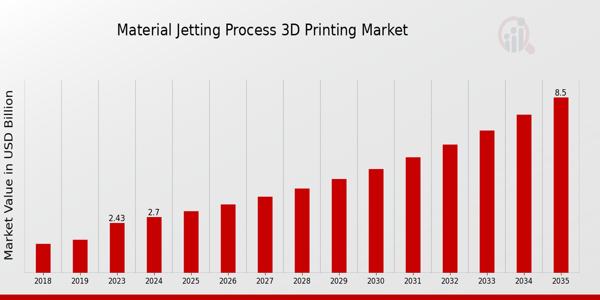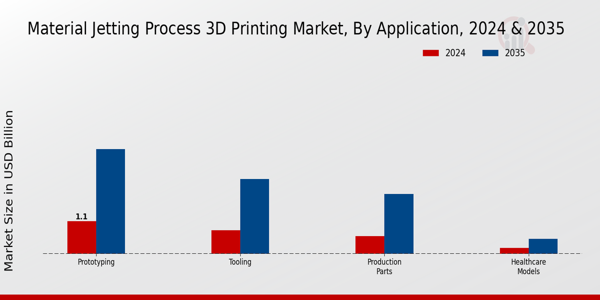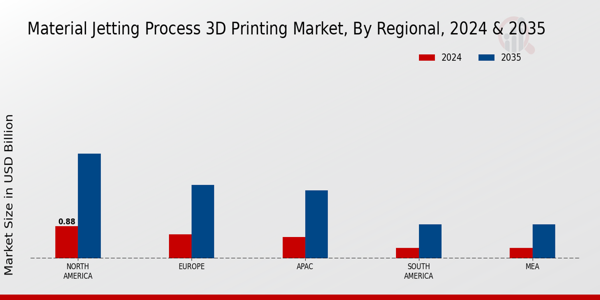Material Jetting Process 3D Printing Market Overview
The Material Jetting Process 3D Printing Market Size was estimated at 2.43 (USD Billion) in 2023.
The Material Jetting Process 3D Printing Market is expected to grow from 2.7 (USD Billion) in 2024 to 8.5 (USD Billion) by 2035. The Material Jetting Process 3D Printing Market CAGR (growth rate) is expected to be around 11.0% during the forecast period (2025 - 2035).
Key Material Jetting Process 3D Printing Market Trends Highlighted.
A number of significant variables that represent the rising need for improved manufacturing solutions are propelling the global material jetting process 3D printing market. The use of material jetting technology is being driven by the growing demand for quick prototyping and customization in sectors including healthcare, aerospace, and automotive.Complex geometries and high-resolution components can be created with this technology, which promotes innovation and shortens product time-to-market. The market is also expanding as a result of increased investment in 3D printing R&D and the need for environmentally friendly production methods.
There are numerous opportunities to be explored within this market, especially as companies look to enhance production capabilities and efficiency. The development of new materials compatible with material jetting, including bio-based and recyclable options, presents significant avenues for expansion.Furthermore, as industries increasingly recognize the importance of digital manufacturing, there is an opportunity for small and medium enterprises to leverage this technology for their specific needs, ensuring a more inclusive growth environment. Recent trends indicate that the material jetting process is evolving with advancements in technology and materials science.
Manufacturers are focusing on integrating automation and artificial intelligence to streamline operations and enhance precision. As technology continues to improve, the market is witnessing a move towards hybrid systems that combine different 3D printing processes, allowing for greater versatility.Moreover, the rise of cloud-based platforms is enabling better collaboration and design sharing among teams, fostering creativity and innovation in product development. The material jetting process is set to become an integral part of the future manufacturing landscape, supporting the transition towards more agile and adaptable production systems.

Source: Primary Research, Secondary Research, MRFR Database and Analyst Review
Material Jetting Process 3D Printing Market Drivers
Advancements in Material Jetting Technologies
The Global Material Jetting Process 3D Printing Market is experiencing significant growth due to continuous advancements in material jetting technologies. These innovations are expanding the range of materials that can be effectively used in 3D printing, including high-performance polymers, elastomers, and composite materials.
Enhanced material properties such as improved strength, flexibility, and thermal resistance are attracting numerous industries to adopt material jetting processes. This technology enables the production of highly detailed and complex geometries with exceptional surface finishes, which is critical for applications in sectors like aerospace, automotive, and healthcare.
Furthermore, as technology becomes more accessible and cost-effective, more manufacturers are incorporating material jetting into their production processes. This trend toward advanced material capabilities is expected to drive innovation and efficiency, significantly contributing to the market's growth in the coming years.
Additionally, the ability to produce small batches and customize products quickly enables businesses to meet specific customer demands, further solidifying the market's appeal. Ultimately, these advancements are paving the way for the broader adoption of material jetting technologies across various industries, increasing the overall market potential.
Rising Demand for Customization and Prototype Development
The rising demand for customization and rapid prototype development is a key driver for the Global Material Jetting Process 3D Printing Market. As businesses seek to differentiate their offerings and respond quickly to market trends, material jetting provides a viable solution for producing tailored products designed to meet specific customer needs.The ability to create intricate designs and modifications without substantial lead times is transforming how companies approach product development.
In sectors such as fashion, consumer goods, and medical devices, the demand for personalized products is increasingly becoming a vital aspect of competitive strategy. Therefore, the ability to efficiently produce customized items through material jetting is fostering industry growth and attracting a diverse range of new players to the market.
Increased Investment in 3D Printing Technologies
The growth of the Global Material Jetting Process 3D Printing Market is largely fueled by increased investment in 3D printing technologies. As more companies recognize the potential benefits of adopting this technology, investment in research and development, as well as infrastructure, has seen a substantial uptick.
This influx of capital is enabling manufacturers to innovate, enhance production capabilities, and reduce costs associated with traditional manufacturing methods. Enhanced financial backing also facilitates collaborations between different stakeholders, promoting the development of new applications for material jetting technologies.Consequently, the improved adoption and acceptance of these technologies across various sectors are contributing to market expansion.
Material Jetting Process 3D Printing Market Segment Insights
Material Jetting Process 3D Printing Market Application Insights
The Global Material Jetting Process 3D Printing Market showcased a diverse range of applications that play a crucial role in its evolution. This market hosted significant segments such as Prototyping, Tooling, Production Parts, and Healthcare Models.
The Prototyping application held a substantial share of the market, valued at 1.1 USD Billion in 2024 and projected to rise to 3.5 USD Billion by 2035. This dominance stemmed from the critical need for rapid prototyping in product development, allowing businesses to create and evaluate prototypes quickly, thereby expediting the design process and reducing time-to-market.
Following closely, the Tooling sector held a market valuation of 0.8 USD Billion in 2024, expanding to 2.5 USD Billion by 2035. The significance of Tooling lay in its capacity to manufacture complex and customized tools efficiently, a key demand in the manufacturing process that improves precision and lowers operational costs.Meanwhile, the Production Parts segment was valued at 0.6 USD Billion in 2024, with an increase to 2.0 USD Billion expected by 2035. This segment underlined the growing trend of additive manufacturing in producing end-use parts, especially where lightweight and complex geometries were essential for performance.
Finally, the Healthcare Models application, although valued at a modest 0.2 USD Billion in 2024 and estimated to reach 0.5 USD Billion by 2035, was essential for creating anatomical models and patient-specific implants, which aided in better surgical planning and personalized patient care.Overall, the Global Material Jetting Process 3D Printing Market segmentation clearly illustrated the robust demand across various applications, indicating extensive growth opportunities and the market's adapting capabilities to meet the challenges and trends within industrial and medical landscapes.
As businesses increasingly sought innovative solutions, leveraging the capabilities of material jetting technology across these applications promised enhanced efficiency, precision, and customization that aligned with modern manufacturing needs.

Source: Primary Research, Secondary Research, MRFR Database and Analyst Review
Material Jetting Process 3D Printing Market Material Type Insights
The Material Type segment is diversified into various categories that play unique roles in applications across industries. Photopolymer materials are essential for creating highly detailed and intricate designs, making them significant for sectors like healthcare and jewelry.Meanwhile, Polymer materials are valued for their flexibility and lightweight characteristics, contributing effectively to automotive and consumer goods manufacturing. Metals are increasingly utilized in applications requiring robust and durable components, particularly in aerospace and tooling, underscoring their importance in high-performance products.
Additionally, Ceramic materials are recognized for their thermal resistance and aesthetic appeal, making them favorable in applications such as electronics and art. The Global Material Jetting Process 3D Printing Market revenue is on an upward trajectory, and the demand for diverse material types highlights both current trends and future opportunities in the market.Each category within the material type landscape contributes uniquely to the overall market growth, catering to a wide range of industrial needs and advances in 3D printing technology.
Material Jetting Process 3D Printing Market End Use Industry Insights
The Global Material Jetting Process 3D Printing Market showcases significant growth driven by its diverse applications across various industries. The End Use Industry segment reveals a strong presence in sectors such as Aerospace, Automotive, Healthcare, and Consumer Goods.Aerospace applications are crucial due to the industry's demand for lightweight, complex components that enhance efficiency and performance. In the Automotive sector, manufacturers leverage material jetting technologies for rapid prototyping and the production of intricate parts, which reduces time-to-market.
The Healthcare industry benefits from tailored medical devices and implants, which utilize the precise capabilities of material jetting, improving patient outcomes. Additionally, Consumer Goods sees increased adoption of customized products that meet specific consumer needs, showcasing the versatility and innovative potential of material jetting technology.As the market evolves, these industry applications contribute significantly to the overall market growth, indicating a robust trajectory for the Global Material Jetting Process 3D Printing Market revenue and highlighting the importance of ongoing innovation within these sectors.
Material Jetting Process 3D Printing Market Printer Type Insights
The Global Material Jetting Process 3D Printing Market showcases diverse applications across various printer types. This market encompasses distinct categories, including Industrial Printers, Desktop Printers, and Professional Printers.Industrial Printers are essential for high-volume production and typically hold a significant share due to their capability to create large-scale components with precision. In contrast, Desktop Printers are increasingly popular in educational and small-scale business settings, allowing for cost-effective prototyping and design.
Professional Printers bridge the gap, offering advanced features suitable for specialized applications in industries like healthcare and aerospace, thereby driving market trends. Each printer type plays a crucial role in the Global Material Jetting Process 3D Printing Market, reflecting the growing demand for versatile, efficient, and high-quality printing solutions.With an expected market growth on the horizon, insights into the Global Material Jetting Process 3D Printing Market data reveal opportunities for innovation and expansion within these printer categories as they collectively cater to diverse customer needs and preferences.
Material Jetting Process 3D Printing Market Regional Insights
The Global Material Jetting Process 3D Printing Market was poised for significant growth, particularly within the regional segmentation, where varying levels of adoption are prominent. In 2024, North America stood out with a market valuation of 0.876 USD Billion, indicating its majority holding in market presence, which is projected to grow to 2.833 USD Billion by 2035.
Europe followed with a valuation of 0.657 USD Billion in 2024, expected to rise to 1.983 USD Billion, underscoring its significant role as a key player in the market. The APAC region, valued at 0.584 USD Billion in 2024 and forecasted to reach 1.842 USD Billion by 2035, exhibited a rapidly growing interest, driven by increasing investments in advanced manufacturing technologies.South America and MEA each held equal valuations at 0.292 USD Billion in 2024, with both projected to reach 0.921 USD Billion in 2035, demonstrating emerging markets with potential growth opportunities.
This diverse segmentation revealed distinct dynamics, where North America's dominance was primarily attributed to its established infrastructure and technological advancements, while APAC's growing market indicated an aggressive pursuit of modernization in manufacturing practices.The robust growth across all regions illustrated the expanding applications and market potential for the Global Material Jetting Process 3D Printing Market, reflecting an increasing demand for innovative manufacturing solutions.

Source: Primary Research, Secondary Research, MRFR Database and Analyst Review
Material Jetting Process 3D Printing Market Key Players and Competitive Insights
The Global Material Jetting Process 3D Printing Market is characterized by rapid advancements and evolving competitive dynamics. This sector is increasingly becoming pivotal in various industries due to its advantages in producing high-resolution, complex geometries with a wide range of materials.As more companies enter this market, the competition intensifies, leading to innovations that enhance product performance, reduce production costs, and improve overall efficiency.
Market players are keenly focusing on technological advancements, strategic partnerships, and regional expansion to strengthen their market positions. The competitive landscape is also influenced by customer preferences for diverse applications ranging from prototyping to end-use parts manufacturing.Understanding the competitive insights within this market is essential for stakeholders to navigate the complexities and identify growth opportunities.
Arevo has established itself as a strong contender within the Global Material Jetting Process 3D Printing Market through its unique approach to composite additive manufacturing. The company leverages advanced technologies to produce high-strength parts with exceptional quality, thereby meeting the needs of diverse industries seeking innovative solutions.Arevo's competitive edge lies in its ability to deliver customized products with shorter lead times, catering to the demand for rapid prototyping and production flexibility.
The company has also made strides in improving material capabilities through its proprietary processes, allowing for greater versatility in applications. With a commitment to sustainability, Arevo's focus on developing eco-friendly materials further enhances its appeal to environmentally conscious clients, solidifying its position as a leader in the market.Sculpteo offers a robust and comprehensive experience in the Global Material Jetting Process 3D Printing Market, combining user-friendly online platforms with a versatile range of materials and technologies. The company excels in providing on-demand 3D printing services that cater to both individual creators and businesses, thus promoting accessibility to advanced manufacturing solutions.
Sculpteo's strengths lie in its extensive experience, allowing it to maintain high quality, competitive pricing, and rapid turnaround times, which are crucial aspects in attracting and retaining customers.Additionally, Sculpteo invests in innovation, continuously expanding its service offerings to include a diverse range of materials and processes, positioning itself as a versatile partner for businesses looking to leverage 3D printing technology. The company's dedication to customer satisfaction and adaptability to market trends contribute significantly to its competitive standing in the industry.
Key Companies in the Material Jetting Process 3D Printing Market Include
- Arevo
- Sculpteo
- Ultimaker
- Materialise
- 3D Systems
- EOS
- Vici Technologies
- GE Additive
- HP
- ExOne
- Formlabs
- Zortrax
- Stratasys
- Nexa3D
Material Jetting Process 3D Printing Market Developments
Recent developments in the Global Material Jetting Process 3D Printing Market reflect significant advancements and growing interest from key players. Companies like 3D Systems and Materialise are unveiling innovative materials and solutions, enhancing the capabilities and applications of material jetting technology across diverse industries.In current affairs, Arrevo's recent expansion in production facilities indicates a robust demand for high-quality 3D printing services. Stratasys has also launched new software that optimizes the material jetting process, which is set to improve productivity and efficiency for users.
Notably, the market has seen a flurry of activity concerning mergers and acquisitions, with Ultimaker's acquisition of a prominent software firm to bolster its 3D print ecosystem and enhance user experience. Additionally, as GE Additive expands its portfolio, strategic partnerships with Vici Technologies are bringing forth cutting-edge solutions in additive manufacturing.The valuation of companies like EOS and HP in this sector continues to rise as their innovative projects in material jetting contribute to industry growth and technological advancements, positioning them favorably against global competitors. The increasing investment in research and development by players like Formlabs and Nexa3D strengthens their market presence significantly.
Material Jetting Process 3D Printing Market Segmentation Insights
Material Jetting Process 3D Printing Market Application Outlook
- Prototyping
- Tooling
- Production Parts
- Healthcare Models
Material Jetting Process 3D Printing Market Material Type Outlook
- Photopolymer
- Polymer
- Metal
- Ceramic
Material Jetting Process 3D Printing Market End Use Industry Outlook
- Aerospace
- Automotive
- Healthcare
- Consumer Goods
Material Jetting Process 3D Printing Market Printer Type Outlook
- Industrial Printers
- Desktop Printers
- Professional Printers
Material Jetting Process 3D Printing Market Regional Outlook
- North America
- Europe
- South America
- Asia Pacific
- Middle East and Africa
| Attribute/Metric Source: |
Details |
| MARKET SIZE 2023 |
2.43(USD Billion) |
| MARKET SIZE 2024 |
2.7(USD Billion) |
| MARKET SIZE 2035 |
8.5(USD Billion) |
| COMPOUND ANNUAL GROWTH RATE (CAGR) |
11.0% (2025 - 2035) |
| REPORT COVERAGE |
Revenue Forecast, Competitive Landscape, Growth Factors, and Trends |
| BASE YEAR |
2024 |
| MARKET FORECAST PERIOD |
2025 - 2035 |
| HISTORICAL DATA |
2019 - 2024 |
| MARKET FORECAST UNITS |
USD Billion |
| KEY COMPANIES PROFILED |
Arevo, Sculpteo, Ultimaker, Materialise, 3D Systems, EOS, Vici Technologies, GE Additive, HP, ExOne, Formlabs, Zortrax, Stratasys, Nexa3D |
| SEGMENTS COVERED |
Application, Material Type, End Use Industry, Printer Type, Regional |
| KEY MARKET OPPORTUNITIES |
Growing demand for customized products, Advancements in material technology, Increasing applications in healthcare, Expansion in automotive sector, Rising adoption in aerospace industry |
| KEY MARKET DYNAMICS |
Technological advancements, Increasing adoption rate, High precision output, Diverse material compatibility, Growing end-use applications |
| COUNTRIES COVERED |
North America, Europe, APAC, South America, MEA |
Frequently Asked Questions (FAQ) :
The Global Material Jetting Process 3D Printing Market is expected to be valued at 2.7 USD Billion in 2024.
By 2035, the Global Material Jetting Process 3D Printing Market is anticipated to reach a value of 8.5 USD Billion.
The market is projected to grow at a CAGR of 11.0% from 2025 to 2035.
North America is anticipated to dominate the market, valued at approximately 2.833 USD Billion by 2035.
The Prototyping application is estimated to be valued at 1.1 USD Billion in 2024.
The market value for Healthcare Models is projected to reach 0.5 USD Billion by 2035.
Key players include Arevo, Sculpteo, Ultimaker, and 3D Systems among others.
The Tooling application is expected to reach approximately 2.5 USD Billion by 2035.
The APAC region is projected to be valued at about 0.584 USD Billion in 2024.
By 2035, the anticipated market size for Production Parts is approximately 2.0 USD Billion.

















